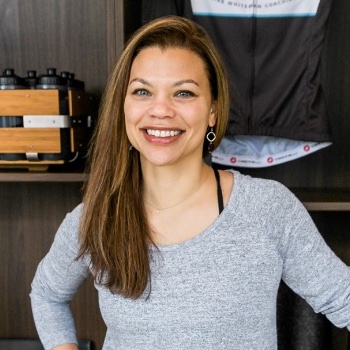Map & Fire Original Research:
The ideal length, focus, and keywords for your marketing messages
How to optimize your headlines, subheadings, and CTAs based on our original research into the messaging of 600 companies.
Too Long; Didn’t Read
1. Talk about the benefits you provide, not just features
This aligns with everything we preach, but it was supported by a staggering 99% result in our Highest Vote companies, where 115 out of 116 companies used benefit-focused headlines. This is compared to just 35% in the Lowest Vote group.
3. Subheadlines are longer but still, keep them succinct
The Highest Vote companies kept subheadlines (aka. subheadings) to a short average of 16.5 words. This was 2.7 words shorter than the Lowest Vote companies at 19.2 words.
2. Headlines can be a bit longer than expected
Based on other studies, the prevailing belief is that optimal headline length is ~6 words. Our results for the Highest Vote companies hedged just a little more at 6.4 words. So, you can go a little longer but not too much.
4. Use all 3 messaging elements to best engage customers
90% of our Highest Vote companies use a headline. 78% pair a subheadline with their headline. 97% then use a CTA. Compare this to the Lowest Vote companies where 92% use a headline, but only 63% use a subheadline and 78% have a CTA.
Introduction to the Research
This study breaks down the key takeaways and insights that we developed based on analysis of website messages from 600 companies across a variety of industries.
The goal was to find relationships that exist between the format of a company’s marketing messages and their success.
Through this process we aimed to create ideas around best practices that can be applied to improve any company’s marketing efforts.
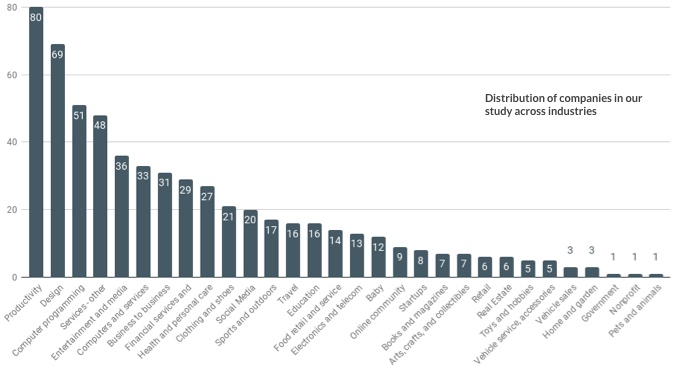
The Message Elements We Explored
1. Headline
What is a headline: This is the biggest, boldest statement at the top of the page. In general, this is meant to capture the core benefit or value proposition for the customer
2. Subheading
What is a subheading / subheadline: This is the statement below the headline. It’s typically a little bit longer and provides additional supporting details on the features and benefits covered in the headline
3. Call To Action (CTA)
What is a call to action: This is the primary action the business wants customers to take – on websites, it’s often in the form of a button or link used to push the customer along in their journey
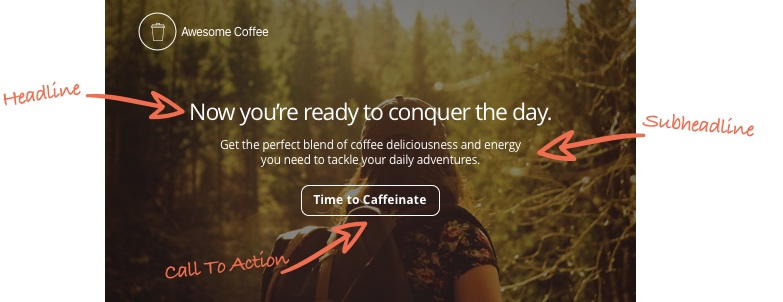
How We Measured Success
The purpose of this research was to look for correlations between a company’s messaging and their success.
This is a tricky element as there are lots of potential measurements of success. You could look at revenue, growth, user base, or many other metrics.
The problem is, that data isn’t available for every business. In addition, when you look across industries, business types, and company maturity, those factors are tough to equalize.
Instead we looked to the people.
The website Product Hunt (producthunt.com) is an awesome online resource for discovering new businesses. On the site, the community is presented with new products and services every day. The users can then “upvote” a company whose offering they like.
There’s no strict definition of what an upvote means, but it’s an indication that the person likes the offering in some way.
Upvotes provide a consistent measure to compare businesses regardless of industry, size, or revenue.
The ability to get upvotes is largely dependent on whether the company is able to engage an audience with what they created.
That’s what marketing is all about.
In the context of this analysis, we selected 500 upvotes as the cutoff between top companies and bottom companies. This is based on a very rough approximation for the threshold a company needs to meet in order to contend for “Product of the Day” (aka. The company that receives the most upvotes each day) on Product Hunt.
A few more notes on the analysis:
- Not all the companies in the study included all the various messaging elements on their website. Totals for each section are based on what elements were present.
- Because our goal was to find best practices, we did a further breakdown to isolate the top 33% of our High Vote companies to determine our Highest Vote, or best-of-the-best practice recommendations.
- Final Note: we’re not affiliated with Product Hunt, we’re just big fans of the site and found their rating system a useful gauge for this research study.
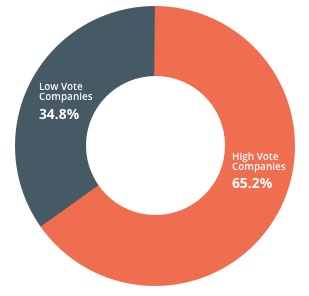
Benefits vs Features In Headlines
One of the most important and powerful aspects of your messaging revolves around not just what you’re saying about your business but how you position it to the reader.
The main distinction we examined was whether companies presented their headline, aka. Their core value proposition, as a benefit statement or a description/feature focused statement.
The reason benefit statements are powerful is that they immediately put customers in the mindset of the value they’ll receive. It helps them to envision a better life. It’s designed to create an emotional connection.
When you focus on basic descriptions and features, you rely on the customer to do the heavy lifting. They have to first understand what you’re offering and then also imagine how it benefits them.
That’s not to say that a descriptive headline can’t work. There may be certain products or certain audiences who respond better to that style. There are no absolutes.
Examples of benefit messages – They focus on how the customer’s life is improved as a result of the product:
- Turn Ideas into Products Faster
- Shopping for your home just got easier
- Get the right music, right now
Examples of feature messages – They only tell you what the offering is:
- Mobile Attribution Analytics
- The professional publishing platform
- A High Stakes Fantasy Football Club
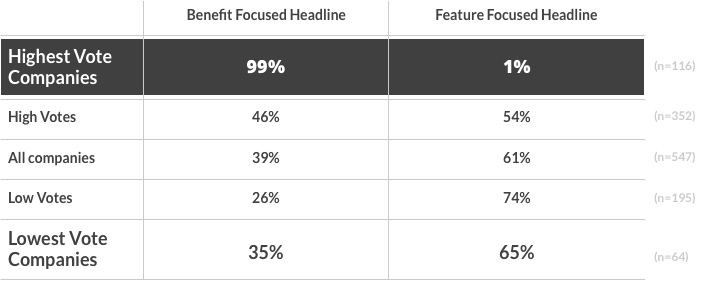
Ideal Headline Length
There’s been quite a bit of research done on optimal headline lengths over the years, but most of it centers around blog articles and social content. Our focus is on website messaging, but the principles are largely the same.
The bottom line is that you need to convey the value proposition of whatever you’re offering in a clear, engaging way.
On initial visits, customers don’t like to spend much time reading, and tend to make quick emotional judgements on what they see.
As a result, the prevailing ideal length for headlines is quite short. Around 6 words.
Our research aligned with this as well.
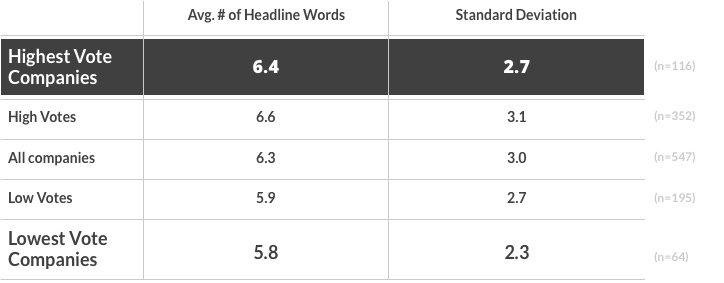
We also looked at the average number of headline characters and saw consistent values across the board.
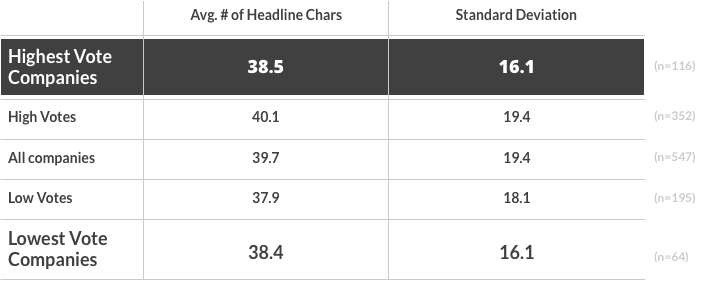
On the surface, the groups aren’t drastically different. When we look at the distribution of headlines across all the lengths, the shapes for High Votes and Low Votes are very similar
But we do see different peaks; High Vote Companies (dark blue) peak at 6 words, Low Vote Companies (orange) peak at 4 words.
If you go too short, your headline could end up being too broad or vague. This may be an issue with the Low Vote group. An extra descriptor word here or there can help clarify and cement your value with a customer.
Again 6 words is about right. But if you want to hedge slightly shorter or longer (5-8 words) you would still be in good company.
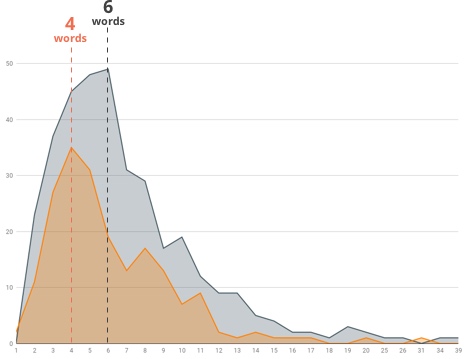
Most Popular Headline Keywords
Here’s a selection of the most frequently used words from our Top Vote group.
(% is of all words used in the headlines):
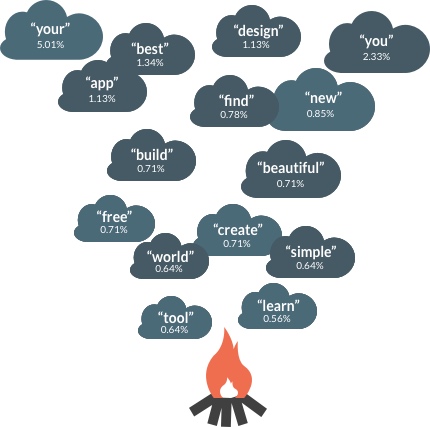
Ideal Subheading Length (aka. Subheadline)
A subheading or subheadline works as a complement to your headline. They can help fill in some of the details of your offering and provide supporting info on the features your customers will most care about.
If you’ve written a benefit-focused headline, The subheadline can be your opportunity to describe what your offering does.
On initial visits, customers don’t like to spend much time reading, and tend to make quick emotional judgements on what they see.
As a result, the prevailing ideal length for headlines is quite short. Around 6 words.
Our research aligned with this as well.
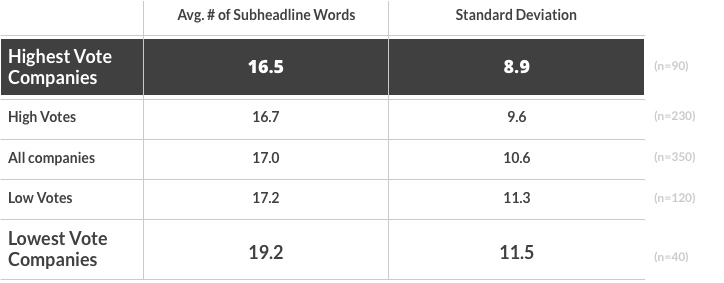
With the subheadlines we see a consistent trend towards longer messages as we move from the highest vote group down to the lowest.
The standard deviations are also fairly high across the board, so we know that these values are much more spread out than with the headlines.
Given that these messages are longer and there may be less common knowledge of best practices, it makes sense that it would be a little more of the wild west out there.
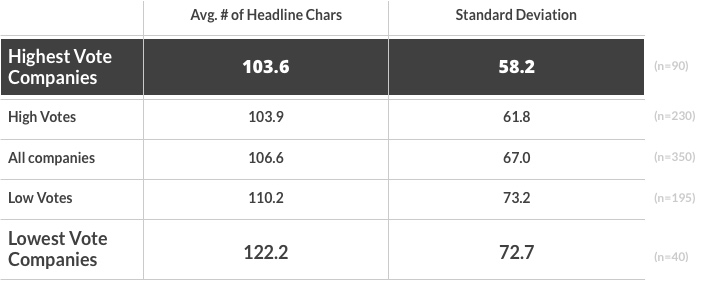
The High Vote Companies (dark blue) have a more condensed grouping (57% coeff of variation) around word count compared to the Low Vote Companies (orange) (66% coeff of variation).
Both groups peak around the 10-11 word range, but the High Vote group is more densely contained under the 20 word mark.

There may be a correlation where lower vote companies have fewer resources available and in turn fewer folks available to help craft their messaging.
But small and large companies are both prone to ramble in subheadlines at time.
Subheading examples that are too long:
Smaller Company:
Tapiriik synchronizes your fitness activities between Garmin Connect, Runkeeper, Strava, TrainingPeaks, SportTracks.mobi, Endomondo, RideWithGPS, TrainAsONE, TrainerRoad, Motivato, Velo Hero, Epson RUNSENSE, Dropbox, Smashrun, BeginnerTriathlete, Pulsstory, Singletracker, Aerobia, and SETIO (your heart rate, cadence, power, and temperature data syncs too).
Massive Corporation:
Inspired by the evolving composition of breast milk, the BabyNes Nutrition System is designed to be in sync with your baby’s changing nutritional needs. With month based precise formula capsules tailored to your baby’s development from 0-36 months, it’s our closest formula to breast milk. The formula capsules work exclusively with the BabyNes machine to deliver hygienic, lump free formula, and a happy bottle feeding experience for babies and parents.
The more effective approach, is a short, focused statement that’s easy to digest quickly.
Subheading examples that are an ideal length:
Tetra uses AI to take notes on phone calls, to help you focus, remember the details, and keep your team in sync.
For years, your team has been split across spreadsheets, docs, and apps. It’s time to bring us back together.
Most Popular Subheading Keywords
Here’s a sampling of high frequency words from the Top Vote group’s subheadlines
(% is of all words used in the subheadlines):
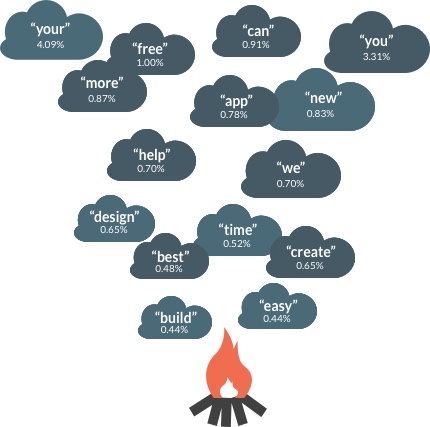
Ideal Call To Action Length (aka. CTA)
A Call To Action is more straightforward than a headline or subheadline. Companies of all shapes and sizes stick to a pretty consistent formula of around 3 words with a focus on strong action verbs.
As consumers we’ve all been sold a million products in our lives, so we’ve had plenty of opportunities to absorb this structure.
With that in mind, let’s look at the numbers:
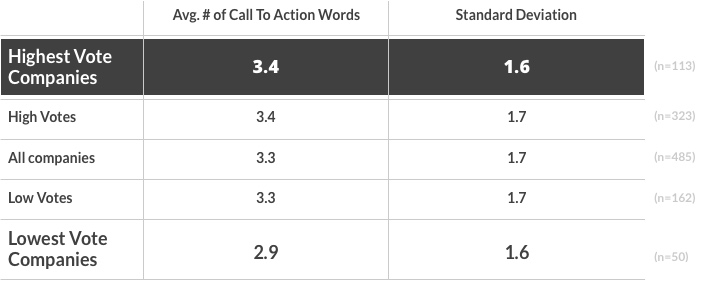
The character counts follow the same trend decreasing slightly with the Lowest Vote companies.

One interesting note is that we see the Top Vote group (dark blue) with a peak word count of 3 as we’d expect, but the Low Vote group (orange) actually peaks at 2.
This represents an opportunity because shorter, 2 word CTAs, tend to follow more generic patterns.
When you add an extra descriptor it allows you to encourage engagement or create specificity to your offering:
Examples of generic 2-Word CTAs
- Learn More
- Get Started
- Sign Up
Examples of more Specific 3-Word CTAs
- Start Free Trial
- Post A Job
- Get the Cookbook
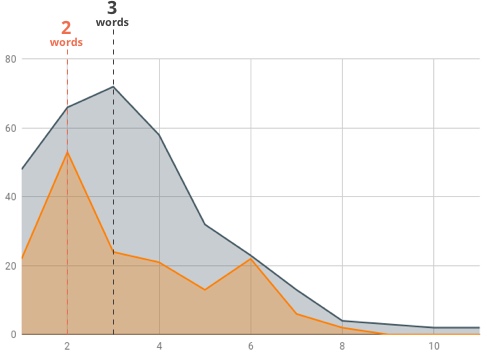
Most Popular Call To Action Keywords (CTA)
Here’s a sampling of high frequency words from the Top Vote group’s calls to action
(% is of all words used in the calls to action):
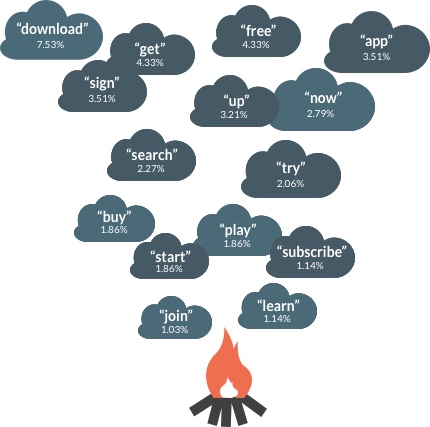
Final Thoughts On The Research
There you go! That’s the summary of our study.
As with any research, this study isn’t perfect and it’s certainly not definitive. This study should simply act as another data point in your toolbox to help inform decisions about your marketing and messaging.
We hope it reinforced some of your existing best practices and helped guide you to some new ideas.
We want to help companies of all sizes and experience levels connect with the people that need their offering. Hopefully this sparked some new paths for you on that journey!
See what these leaders have to say about working with Map & Fire
Some Of The Brands Who Trust Us

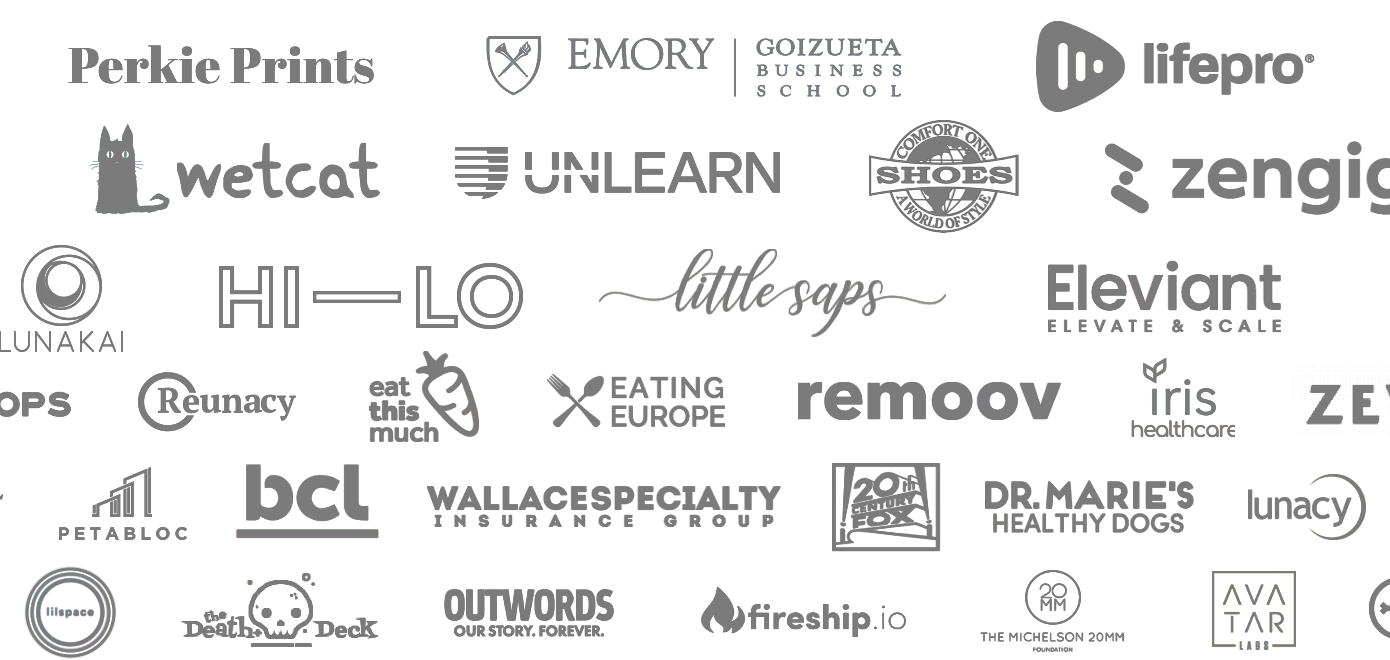
Get Access To Our Workbook And Insights
Our Content Is Featured In:

Join 6,538 folks who receive our latest insights and you'll get immediate access to our 10 page brand strategy workbook!





